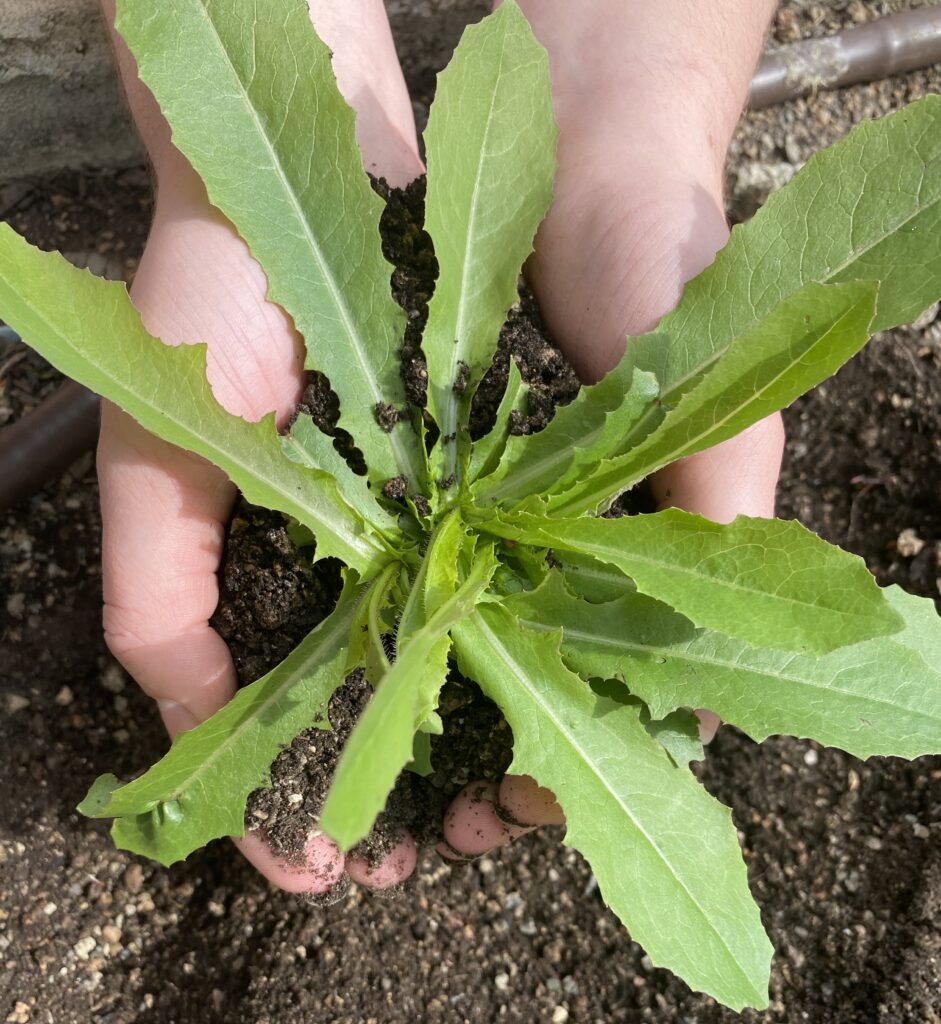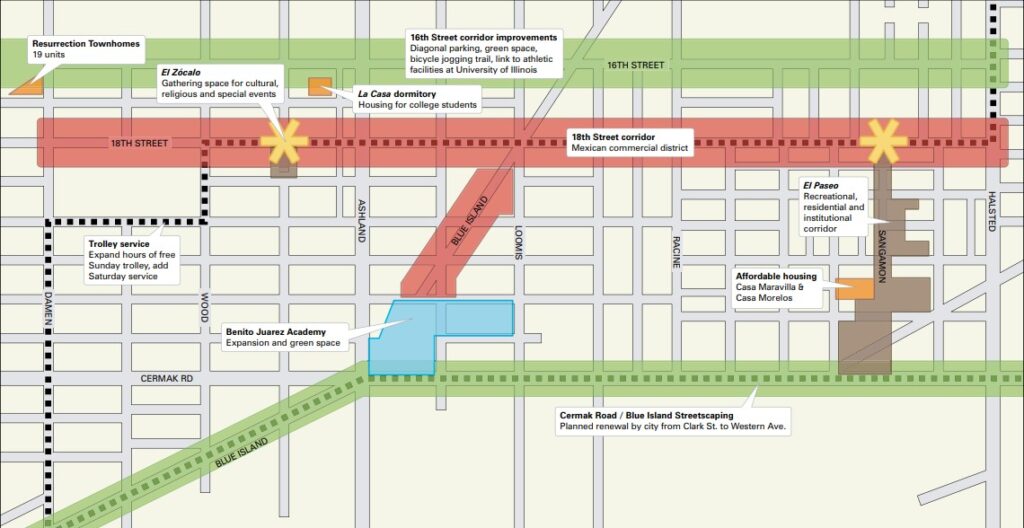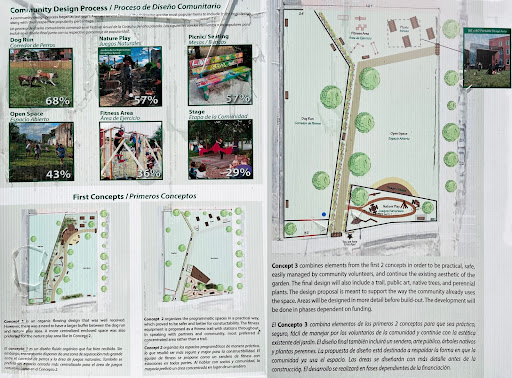Community and History
Contributors: Kimberly Allotey, Layla Haynor, Kenatu Habtaslassa, Sallie Hinkle, Griffin Seyfried
Community and History Podcast
Transcription of Podcast
Introduction – History of Pilsen
Kim: Hi to all our listeners.
Kenatu: Before we get started, this is our first episode so I think we should introduce ourselves. Who wants to start first?
Layla: Hi, I’m Layla. I’m a third year student at the University of Chicago.
Kim: Hi, I’m Kimberly, I’m also a third year student at UChicago.
Kenatu: And, I’m Kenatu and I’m also a third year student. This podcast is a product of the collective effort of the Mapping Global Chicago students. This year our challenge was to tackle issues on environmental justice and diaspora.
Kim: To do this we worked closely with a community in the east side of Pilsen called El Paseo Community Garden. There we got very active with the garden’s stewardship days, film screenings, and other events that we will dive into later in this podcast. For now, I think it’s best we ground ourselves in this area through its history. Layla, would you like to take it away?
Layla: Yeah of course. Do you have any specific historical questions you are interested in?
Kim: Well, are you familiar with Pilsen and Chicagoland?
Layla: Yeah so I moved to Chicago for university and have become really familiar with the Hyde Park area, but through this class and our research efforts I have also become a little more familiar with the Pilsen area as well. However, I would definitely not go so far as to say I am an expert on either area.
Kenatu: Oh of course. Well can you tell us what you have learned through your research? How far back did you look?
Layla: So I tried to go as far back as I could with census data and general population data, but in doing so I discovered something pretty interesting. I realized that on official documents and in population data the definitions of Mexican and Hispanic have varied greatly over time. For example 1930 was the one and only census that categorized Mexican as its own independent racial identity. But even more shocking to me was that it wasn’t until 1960 that people could self-identify their race. Before that point, someone’s race was determined by the census takers, with many non-white races being classed as Black. Then in 1970, for the first time, questions about Hispanic origin were included on the official US census. I think what I am trying to get at is that with all of this talk about identification and demographics, it’s important to remember that this information does not always reflect how people truly identify themselves or their communities. And all of this to say, the bulk of my historical research starts around the 1950s and 60s and works up to today.
Kim: That’s pretty interesting. Especially since identity is such a big part of finding or creating communities. Can you tell us a little bit more about what the population of Pilsen looked like throughout the years then?
Layla: Of course! It seems like the well-known predominantly Mexican population of today’s Pilsen really began in the 1950s. Before then it was largely a working class immigrant city with people mainly coming from Czechoslovakia and the surrounding countries. However, after the post- WW2 white flight left neighborhoods such as Pilsen in rough shape, there was a large push for urban renewal programs from city developers that inevitably pushed minority groups living in Chicago out of their neighborhoods. This period of urban renewal and rebuilding was really what pushed the Mexican/Hispanic communities into Pilsen. First with the building of the Stevenson expressway in 1956 and then with construction of the University of Illinois Chicago downtown campus in the early 1960s. Time after time, the Mexican and Hispanic communities were displaced in favor of urban renewal projects that did not offer any benefits to them.
Kim: And was the shift in population sudden or was there some gradual movement of the Hispnic community into the Pilsen area?
Layla: Based on the census reports of the Pilsen area from 1980-2020 the shift in population seems very sudden. Looking at the difference in population from 1980 to 1990 seems to show a large change in the ratio of white residents to Hispanic residents, with 1990 ending up with a predominantly hispanic population.
Kenatu: Wow and how does that tie into the formation and history of the El Paseo community garden?
Layla: Great question. As communities from all over Mexico and the global south were pushed together in this neighborhood, there was a strong drive to create a space to properly acknowledge and celebrate these histories. Many different cultural projects have been born out of this new Hispanic community, including El Paseo. But I will turn to Kenatu to give a more in-depth look at the creation and history of the El Paseo Community Garden specifically.
Part 2 – History of the Garden
Kenatu: What might not be commonly known about the garden is that it sits on what was once the Burlington Railroad (BNSF). This railroad was out of use and became incredibly polluted/contaminated and was dubbed a “brown area” where nature struggles to thrive. “In the summer of 2016, the U.S. Environmental Protection Agency (EPA) began the environmental remediation along the first phase of El Paseo Trail on Sangamon Street from 16th Street to 21st Street. These efforts included the removal of contaminated soil within the existing BNSF Railroad property. This clean-up was completed in Spring of 2018”
Layla: Did this have any effects on how the garden was built?
Kenatu: Yes, despite the efforts to remove the waste, the land still has its limitations. When chatting with Paula, one of the heads of the garden, she shared that the usable soil does not go very deep into the ground so they are unable to plant trees and have made raised beds to plant vegetables, herbs, and flowers. Another thing to know is that the BNSF railroad still owns the land that the garden is on so that has an effect on how the land is used.
Kim: Tell us more about the founding of the garden.
Kenatu: El Paseo was founded in 2009 by local residents in the area before it became a green space. The City of Chicago decided to build a sidewalk for the tenants of an affordable housing unit being built nearby and they then approved the creation of a small community garden on the contaminated lot but provided no funding for it. Undaunted, the founders – Paula and Antonio Acevedo – decided to push forward and start the work of making the community space that we see today
Layla: What does the garden look like for those who have never been?
Kenatu: The garden is the combination of lots in between Cullerton St and 21st St that has a multi use walking trail that runs through its center. The different sections of the garden are allocated to various cultivating and functional spaces. As for the elements within the garden, El Paseo Community Garden features raised garden beds that grow seasonal vegetables and flowers, art installations such as murals and usable furniture, different types of terrain such as the prairie, traditional grass and the reminiscence of the rail lines. They also have made an outdoor classroom, an apiary that houses bees, and a dog run.
Layla: Yes they certainly feature so many things for a garden of their size. If you want to see all together you can volunteer at the garden for their Sunday st
2013 – EPA removes the contaminated soil. After years of lobbying the federal government, the polluted soil is removed and the garden goes into “high gear”, transforming the area into an abundant planting and gathering space for the neighborhood.
2017 – El Paseo mural project begins. El Paseo became home to a three phase mural project to showcase the history of Pilsen and to celebrate Latino culture. The murals serve as a vibrant visual depiction of the past and enduring legacy of Pilsen’s immigrant community
2018 – El Paseo receives the Chicago Excellence in Gardening Award (Special Award: Larger than Life). The competition for this award represented 33 wards and 60 neighborhoods and the gardens featured ranged from little parkways to school farms with animals and greenhouses. This award comes from the Chicago Excellence in Gardening Awards (CEGA) which is Chicago’s only citywide gardening honors recognizing the work that goes into making Chicago a healthier, more beautiful and sustainable place.
2020 – El Paseo receives the John D. and Catherine T. MacArthur Foundation Creative Placemaking Award. This award recognizes projects in the Chicago region that leverage the power of the arts, culture, and creativity to serve a community’s interest while driving a broader agenda of change, growth and transformation in a way that builds character and quality of place.
Now –
Future – Plans to expand about a half acre to include a dog run, community stage, fitness area, a nature play area for children, and several more gathering spaces and plant areas. The garden aims to connect with other nature trails via natural prairie paths
Part 3 – History of the Trail
Kim: The main question that I wanted to tackle regarding the community garden is related to gentrification, however, I will preface that we have another group solely dedicated to gentrification and policy, so they will speak on the topics that I bring up here, in more depth. I think it’s safe to say that my research is, instead, trying to invoke more thought about our relationships with nature and community gardens. I know that sounds like a weird jump, but I promise it all circles back to El Paseo. Are you guys aware of the Bloomingdale Trail?
Kenatu: The 606?
Kim: Yes, exactly. In 2006 there was a Pilsen Quality of life plan that intended to connect the Pilsen corridor, which is where El Paseo community garden is, to a four mile trail that connected a few other corridors such as Cermack and Little Village. A few of the plan’s main goals were to expand housing options for Pilsen residents, build a stronger neighborhood economy, make Pilsen a self-reliant, family-oriented community, and develop educational opportunities for residents of all ages. Of course, this sounds much better on paper than how it was slowly executed. I wasn’t able to see exactly when the trail was named but it’s known as the Paseo trail or El Paseo trail. This caused the community garden, due to its proximity in location and name, to be highly criticized. Paula had initially brought it up during one of our many conversations regarding the trail. But I found it very odd. The 606 isn’t even in the same neighborhood as El Paseo, yet it still served to be an issue for the garden.
For example, in one of the articles that I’ve read from the Chicago Sun Times, Aldermen Danny Solis and George Cardenas had this to say about the Paseo trail. Solis called the path a “poor man’s 606,” but Cardenas said there would be no mistaking the Paseo for the $95 million Bloomingdale Trail.
Layla: It’s kind of like he’s saying let’s really emphasize the white folk from the latinx folk…
Kim: Right. But this had me thinking really hard about the comparison being brought up in the first place and why Paula and other members of the garden and Pilsen community are both rightfully annoyed and paranoid. In class, we discussed in detail about how removed humans are from nature, so parks and gardens become hot commodities, amenities to bring in an influx of developers and realtors. This is very much the case for the members of the Pilsen community. In two articles that I read, one called “Brownsfield to Greensfield” and the other called “Pilsen Community Split Over Who Will Benefit From Paseo Trail”…
By the way, these articles will be linked in our sources section of the article. All references will be, so please look out for that if you want to read on what we’ve read.
Anyway, both articles reference crime in relation to nature. In NYC, “community gardens have improved property values, enhanced neighborhood aesthetics, and reduced crime rates sufficiently to interest developers in investing in the neighborhood” and the plan for Paseo in Chicago “encourages ‘a larger presence of people using the streets for positive activities’ which will help ‘reduce crime and the perception of danger’”. Did you guys notice anything in the quotes I just read?
Kenatu or Layla: filler text
Kim: For the quote regarding NYC, community gardens are specifically being used to interest developers in investing in the neighborhood. So what does that mean for the residents that are currently residing there once those developers do get interested?
Kenatu or Layla: filler text
Kim: Yes! You get it. This is how I really started to understand how “rails-to-trails” projects are all connected. Because of the existing examples of these projects and seeing who benefits from these resources, typically white people, when you apply these plans to a predominantly minority community that could potentially be of lower income it is simply now because the thought of having these greenspaces that drastically heightens the chances for gentrification and thus displacement which Paula has already mentioned affected many of the previously recurring members of the garden. They’ve had to move to many other neighborhoods: Back of the Yards, Cicero, outside of Pilsen, the suburbs, any and everywhere that was more affordable than their quote unquote affordable homes in Pilsen.
So then, what will happen to El Paseo in the future? Paula has mentioned how closely the garden and few other gardens are working with Neighbor Space, a non-profit urban land trust that protects Chicago’s community gardens from developers through property ownership and insurance coverage. Not only will Paula and the other garden leads continue working with Neighbor Space but Paula wants to acquire some of the abandoned property in the area of the garden to ensure that the garden has a firm defense against being bought out by investors and developers.
I want to end off my piece here with just asking you guys and the listeners to think about your own relationship with nature.There are so many ways I can pose this question, but I want you to focus on this: how exactly can we make sure that all communities are able to truly reconnect with nature in a way that doesn’t harm the residents?
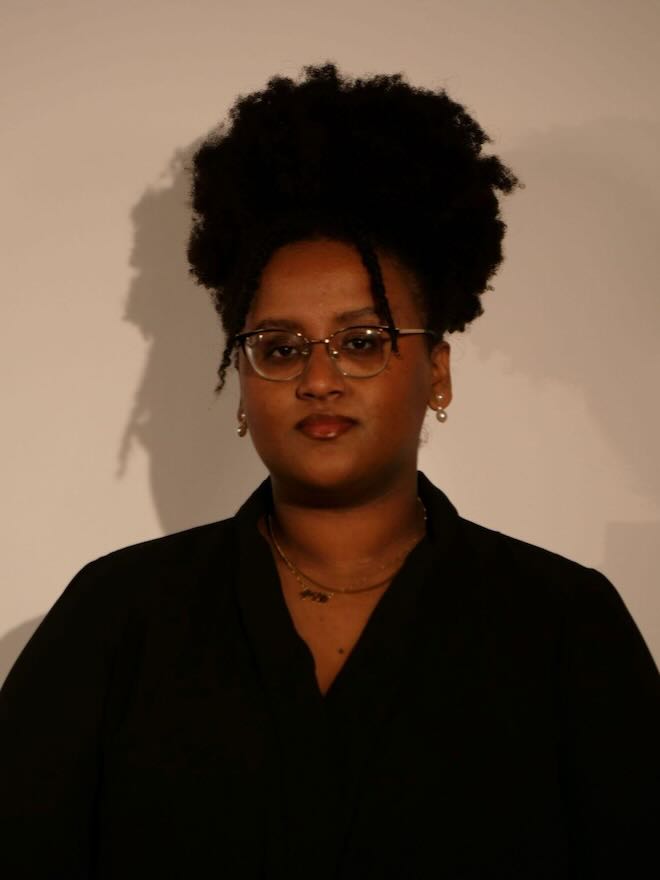
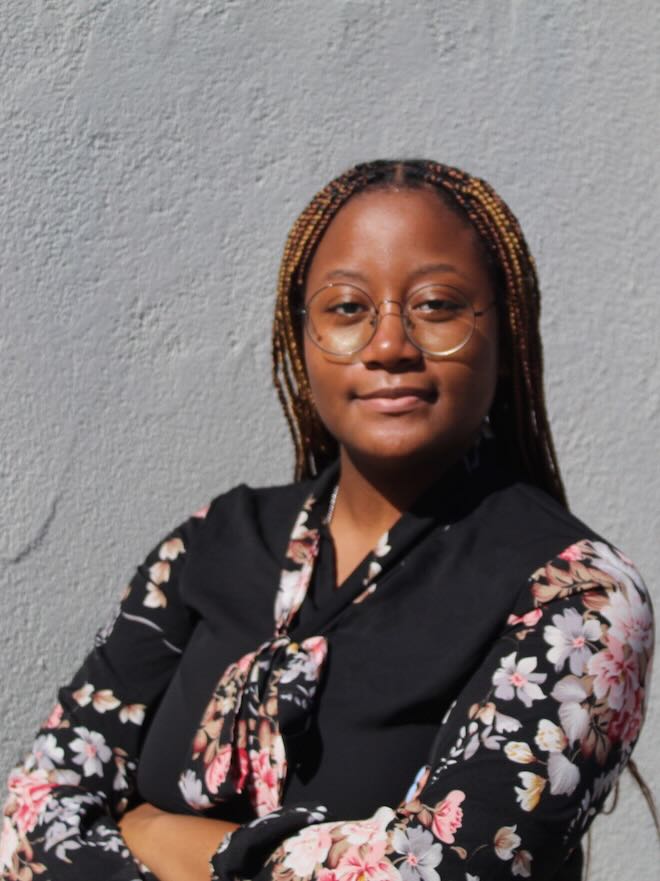
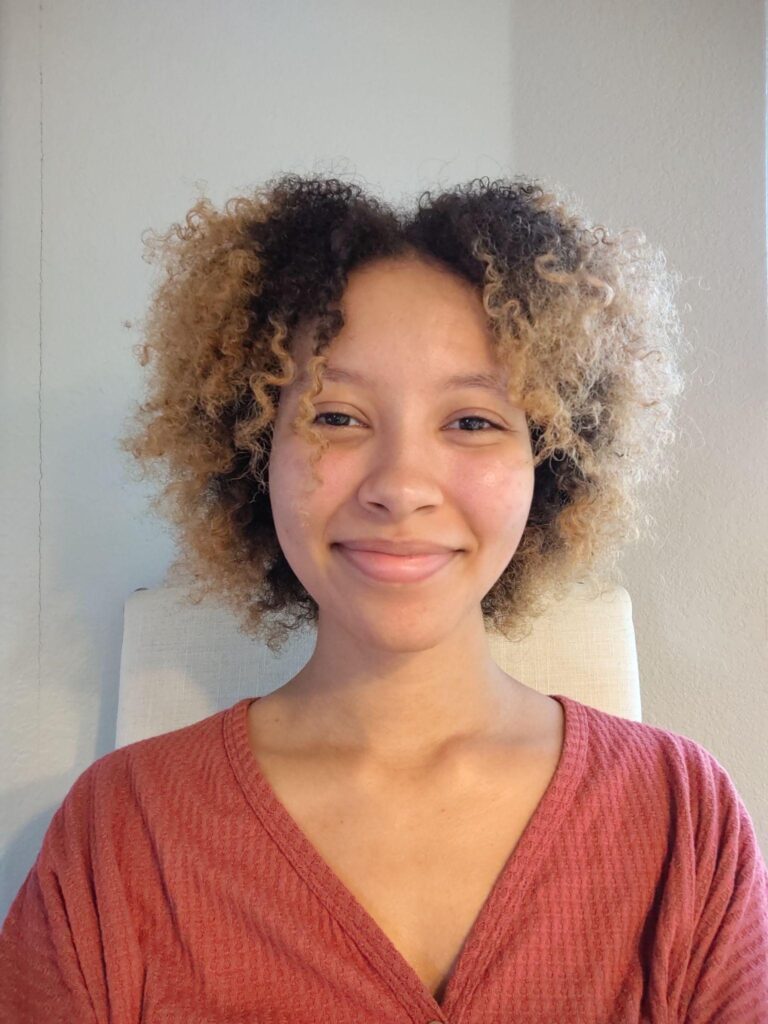
Demographics of the Neighborhood
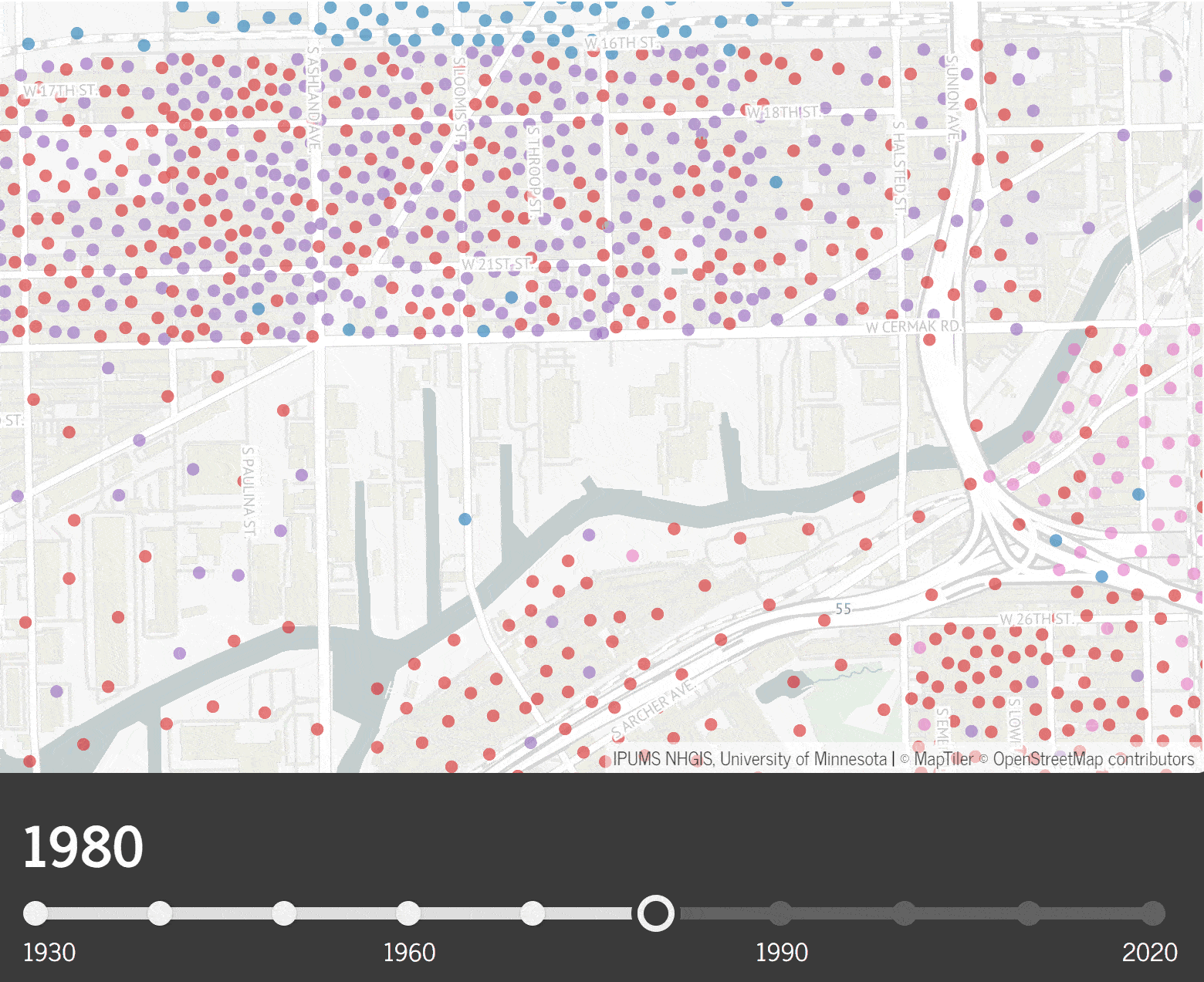
Sourced by Layla from the WTTW: First Hand Segregation project and animated by Griffin Seyfried
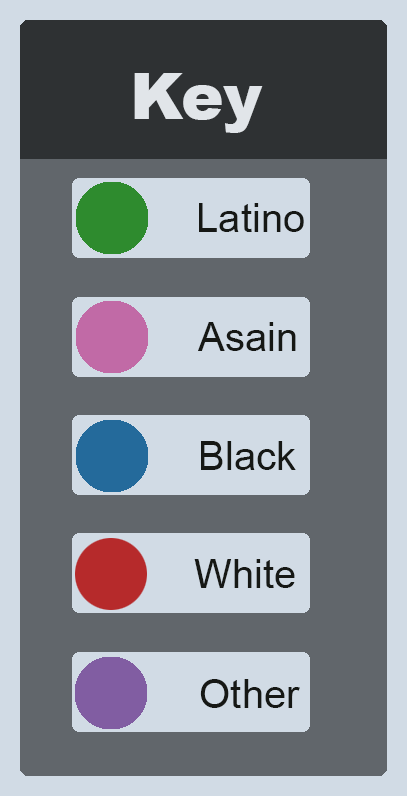
The animation above illustrates the changing demographics of Pilsen and the larger lower west side from 1980 until 2020.
Community and Fostering Relationships Through Garden Events
As discussed in the podcast, though the demographics of Pilsen show an overview of when many Latinx and Hispanic community members first moved into Pilsen, they don’t tell us much about where these residents came from. Based on various articles and the Nuestra Herencia film created by the El Paseo Community Garden members, many members of the Latinx community in Pilsen have origins in Northern and Central Mexico. Just looking at the digital story map of the documentary, some of the current elders’ hometowns featured in the documentary include Durango, San Luis Potosi, and Mexico City.
Though many garden members don’t share the same hometown community, through working with the El Paseo Garden they have created a new community in Pilsen. Thinking specifically of the elders in the community, some of the collective garden members spoke on how the seniors come to work on their garden beds at least once a week. Even outside of the elders, many of the collective members, though they are non-Hispanic or non-Latinx, have also found a sense of community within the garden and have become dedicated members over the years. They volunteer their time during the weekends to work on the collaborative spaces and to help run the many events the garden hosts throughout the year.
As all the members of the community come from different hometowns and origins, the garden acts as a shared focal point for the residents of Pilsen to gather together. To promote this sense of community and give members access to activities outside of gardening, Paula and the other leaders of the El Paseo Community Garden host events within the garden. For example, the garden offers a variety of healing events aimed to help people connect with nature. These events include things like yoga. meditation, and sound healing which help offer alternative ways for individuals to improve their physical and mental health. They also host events to celebrate holidays like Mother’s Day and have market days where they sell some of what they produce along with supporting community vendors. Many of these festivities include performances like flamenco dancers or traditional bands, making it a time to look forward to for all who call the garden home.
History of the Latinx and Hispanic Community in Pilsen
The history of the Latinx and Hispanic community in the Chicago area goes all the way back to the mid 1910s. Around this time many workers and farmers moved from Central Mexico, from states like Guanajuato, Michoacán, and Jalisco, to Chicago primarily because of the Mexican Revolution. There they lived alongside a majority Czech and Eastern European population. Though this is when the Latinx community first began to grow in Chicago, it wasn’t until the 1950s that the Latinx population increased exponentially in the Pilsen area.
After World War 2, many middle- and upper-class White residents moved from the city proper to the suburbs of Chicago in what is known as the “White Flight.” This “White Flight” left the inner city, now with a majority minority population, in an abandoned and neglected state. Around the same time as the “White Flight,” Chicago elected Richard J. Daley as mayor. Unfortunately for minority communities in the city, Mayor Daley was a big supporter of urban renewal projects and worked hard to push many through during his term. These projects repeatedly targeted neighborhoods with a majority Black and Latinx population, pushing them out of their housing and communities over and over again. Two specific projects, the building of the Stevenson Expressway (1956) and the University of Illinois Chicago downtown campus (early 1960s), were responsible for pushing the Latinx community out of their previous neighborhood around Hull House and into Pilsen.
History of El Paseo
El Paseo Community Garden, on W 21st, is a historically polluted, brown field site that was revitalized as a community garden in 2009. The space is intended to foster community and promote individual wellness. The garden engages youth and adult volunteers and community members through stewardship, conservation, placemaking, partnerships, programming, community gardening, and learning activities and events. The garden has become one of many NeighborSpace protected and community managed spaces in Chicago.
With over an acre of green space, El Paseo features a wide array of natural and built spaces including a dog run, fitness area, a group yoga and exercise space, wildflower meadows, a native plant permaculture space, an apiary, and individual and community food gardens as well as several multipurpose spaces well equipped for teaching, and performance/exhibition events.
Learn About the Soil
Image by Sallie Hinkle
The land which the garden inhabits was once an industrial metal smelter that had long been abandoned, seeping toxins into the soil and harming the surrounding community for decades. Heavily polluted and contaminated, the land was dubbed a “brown field area” where flora struggled to take root, causing community members to avoid and ignore the space. El Paseo was founded in 2009 when the City of Chicago approved the creation of the small community garden on the contaminated lot to supplement affordable housing being built nearby, albeit the city provided no funding nor support to the garden.
Initial plans to develop the polluted site involved constructing raised beds with safe soil for produce and flowers to be planted in. After years of lobbying, in 2013 the EPA finally removed the contaminated soil and the garden went into high gear: expanding the number of planting beds, seeding wildflower meadows, and forming a natural permaculture site. Over the years, the garden added several activity and play areas, allowing El Paseo to emerge as a vibrant community area boasting stunning murals and weekly activities that appeal to loads of visitors and Pilsen residents.
Did you know?

In 2018, El Paseo received the Chicago Excellence in Gardening Award (Special Award: Larger than Life). The competition for this award represented 33 wards and 60 neighborhoods, with featured gardens ranging from little parkways to school farms with animals and greenhouses. This award comes from the Chicago Excellence in Gardening Awards (CEGA) which is Chicago’s only citywide gardening honors recognizing the work that goes into making Chicago a healthier, more beautiful and sustainable place.
Awards like these are important in recognizing the impact of El Paseo’s work in making Pilsen, as well as the larger Chicago community, a healthier and happier place. Green spaces are imperative in forming safe, clean, and sustainable areas for people to meet, play, and get in touch with nature. At El Paseo, people are able to connect with each other and the world around them in ways that have been previously difficult in urban areas.
The Trails Project
History:
In November 2006, the initial Pilsen Quality of Life Plan was created as a resurrection project by the Local Initiatives Support Corporation (LISC) and Chicago’s New Communities Program. The purpose of this plan was to strengthen the presence of the rich culture and community that Pilsen has by connecting community organizations, public schools, Catholic schools, churches, park and other recreational facilities as well as cultural facilities in the height of the growing job base and housing market that threatened these factors and limited residents’ access to them.
“As others discover the beauty of our housing stock and the vitality of our local economy, it is up to us to protect and nurture the culture that has made Pilsen what it is.” – LISC
The 2006 plan only intended to enhance the major corridors in the community such as 18th Street, Blue Island Avenue, and the Sangamon railroad corridor. However, in 2016, Mayor Rahm Emanuel, with the Chicago Department of Planning and Development (DPD), announced the “Paseo Trail” the new “rails-to-trails” project that would connect Pilsen, Cermak, and Little Village to provide opportunity for recreation, culture and beautification. It is important to emphasize that the “Paseo Trail” was announced after the establishment of the “El Paseo Community Garden” in 2009. The garden, a critical part of the original 2006 plan, is not officially affiliated with the “Paseo Trail” despite the misconception of the naming of the trail “(El) Paseo Trail”. The existence of the community garden has only been an asset to the planned 4.2 mile trail which aims to connect other gardens. The trail itself was to be completed in 3 phases with phase 3 expected to be completed within 2023.
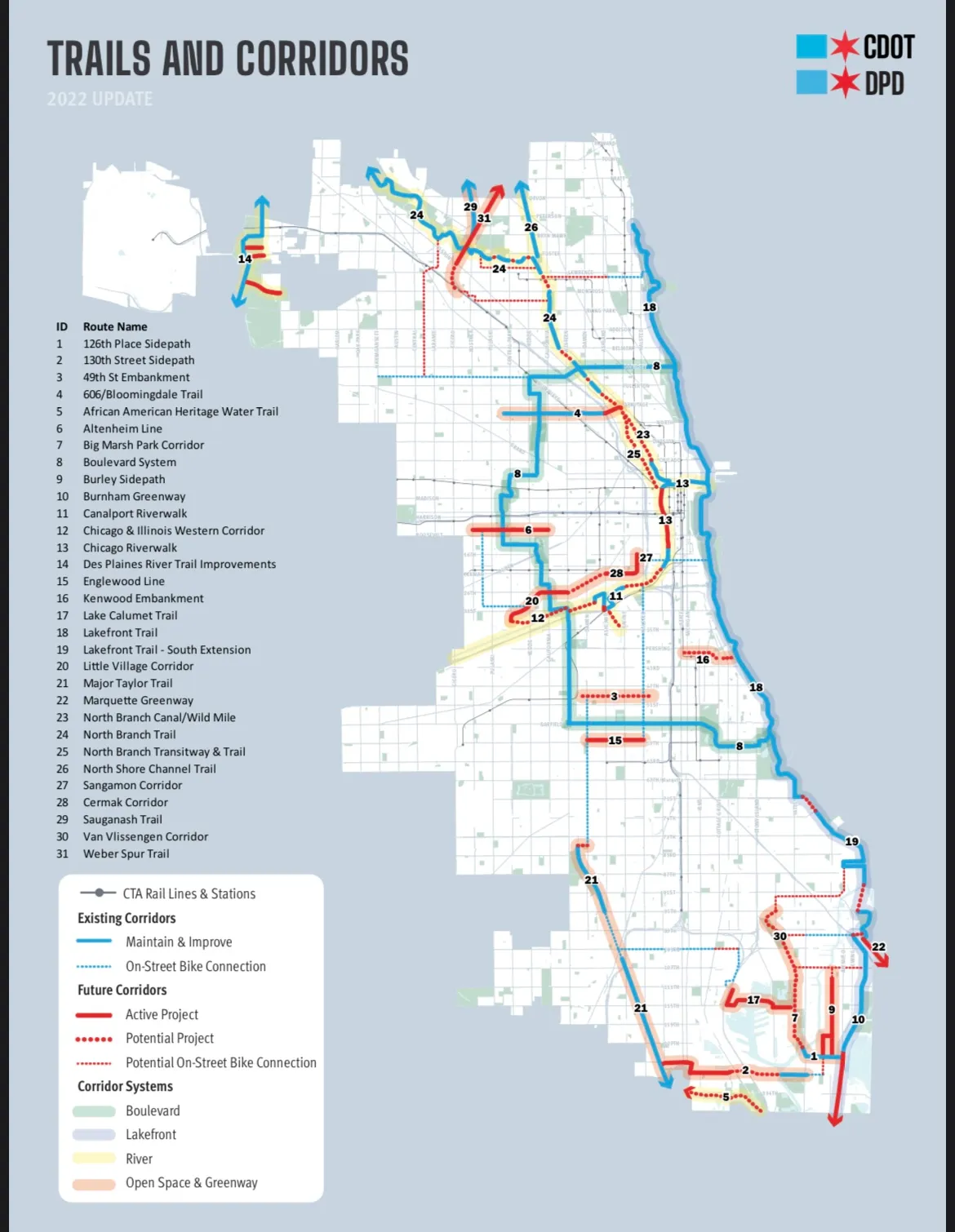
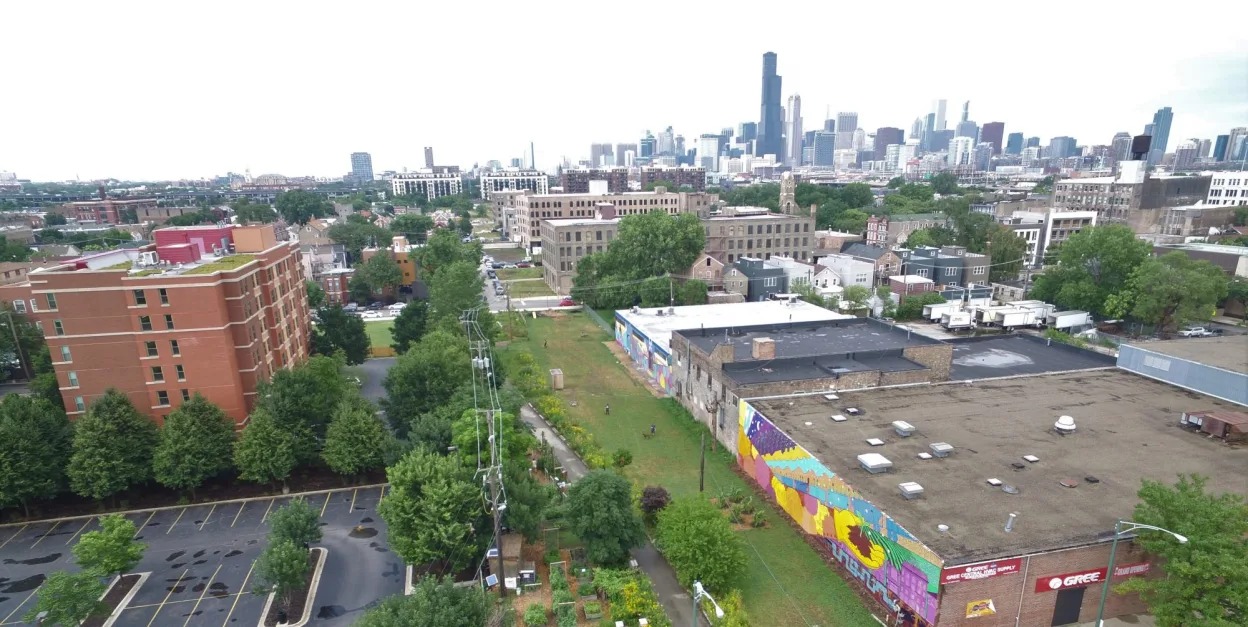
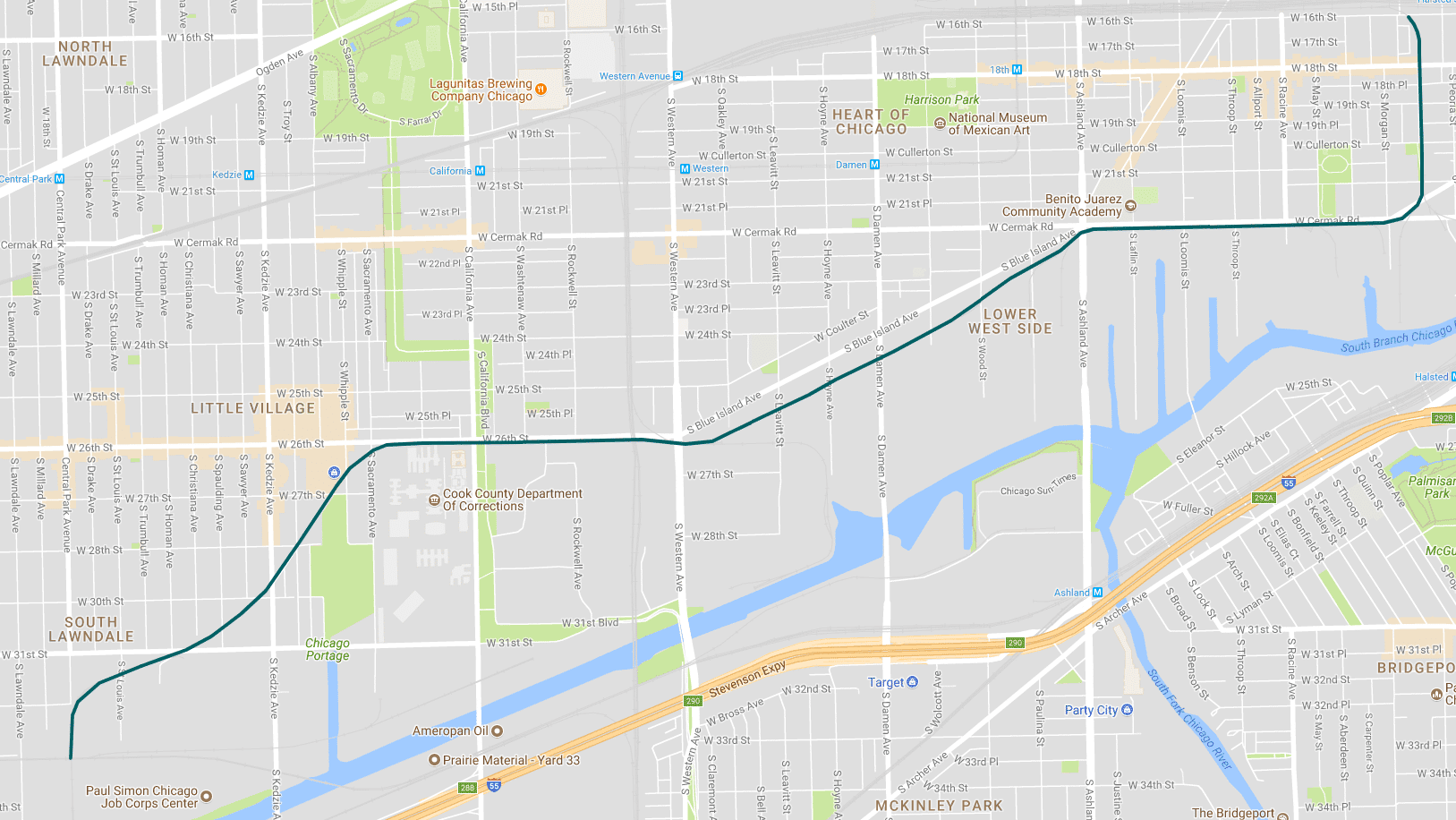
Image from Google Maps
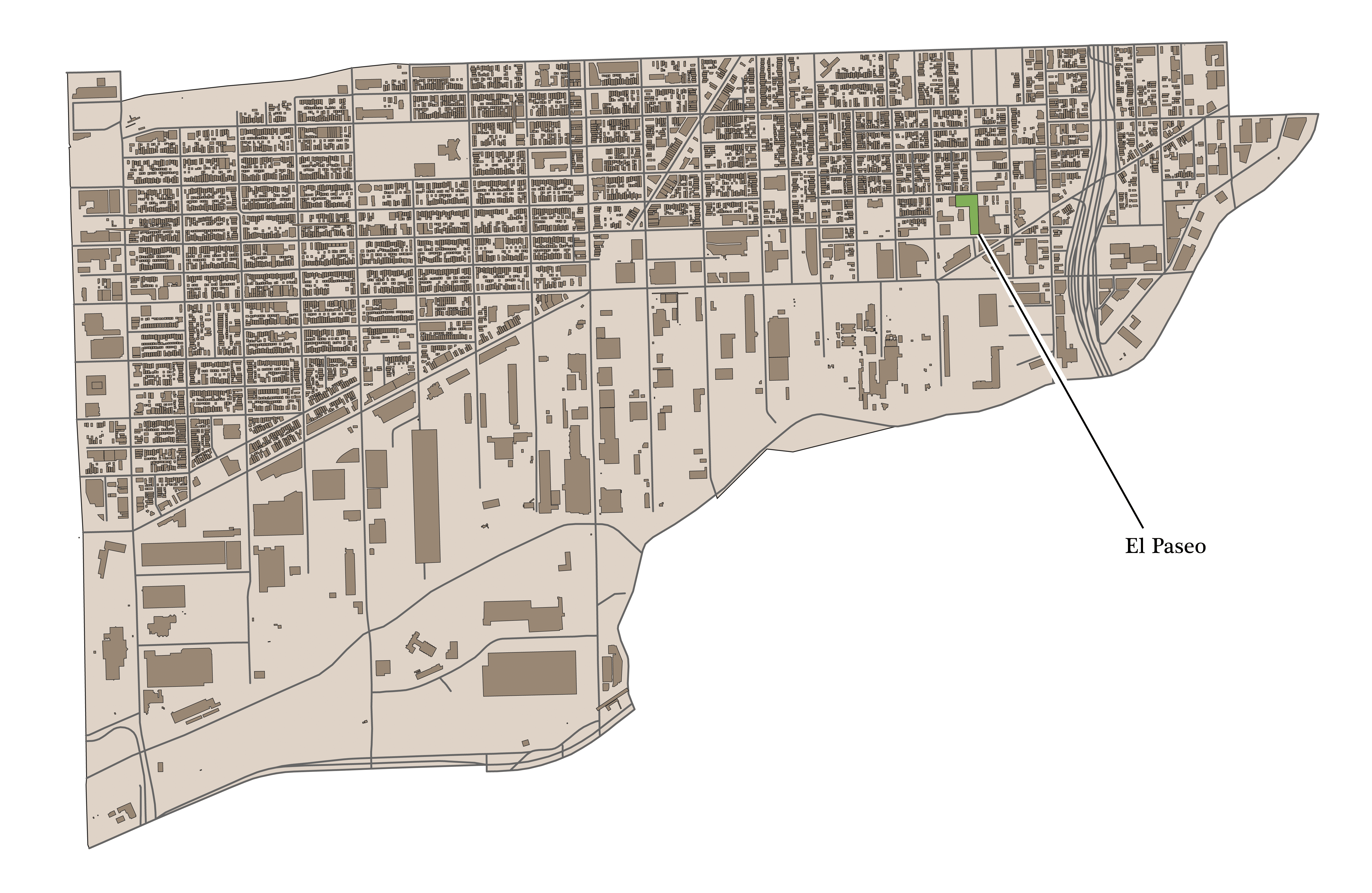
Image by Griffin Seyfried
Today:
The outcome that the original 2006 resurrection project wanted to prevent was greatly expedited due to the “rails-to-trails” project. The community was preyed on by investors who pushed previous community members out of Pilsen. As of now, Phase I has been completed and so the following phases that the Chicago Department of Planning and Development (DPD) are working on are taking place in the Cermak and Little Village corridors. While the Pilsen corridor is not directly being worked on now, the effects of the previous phase are noticeable amongst the community members. Once the full scope, 4.2 mile trail is actively being worked on, including the surrounding area of the El Paseo Community Garden, Paula Acevedo–co-director of the garden–and other leadership will continue to work with Neighbor Space–a non-profit urban land trust that protects Chicago’s community gardens from developers through property ownership and insurance coverage–and other non-profit organizations to defend the community against these developments. In more fortunate news, the greater Pilsen community strikes back as best they can to slow gentrification in Pilsen by imposing demolishing fees to property owners, and spreading the word of the horrible circumstances that impact the community.
El Abrazo Mural
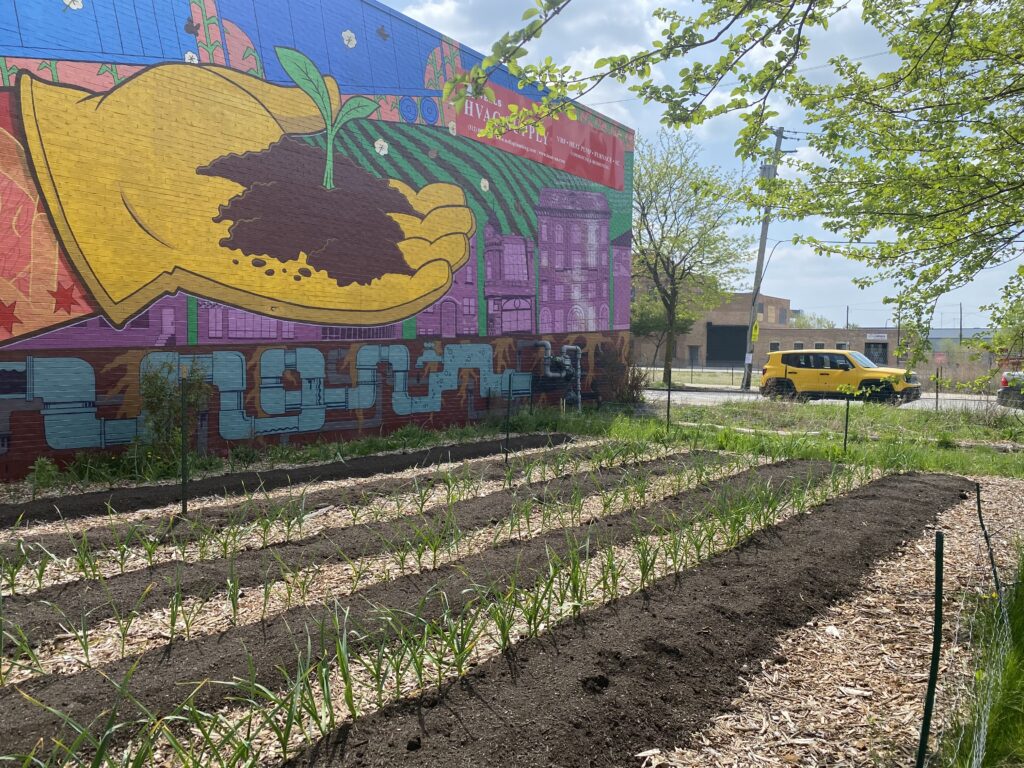
Image by Sallie Hinkle
The garden began its mural project in 2017, intending to use art to showcase the history of Pilsen and to celebrate Latino culture. In 2020, El Paseo received the John D. and Catherine T. MacArthur Foundation Creative Placemaking Award, in part due to featured murals. This award recognizes projects in the Chicago region that leverage the power of the arts, culture, and creativity to serve a community’s interest while driving a broader agenda of change, growth and transformation in a way that builds character and quality of place. To this day, the murals serve as a vibrant visual depiction of the past and enduring legacy of Pilsen’s immigrant community.
Future Plans at El Paseo
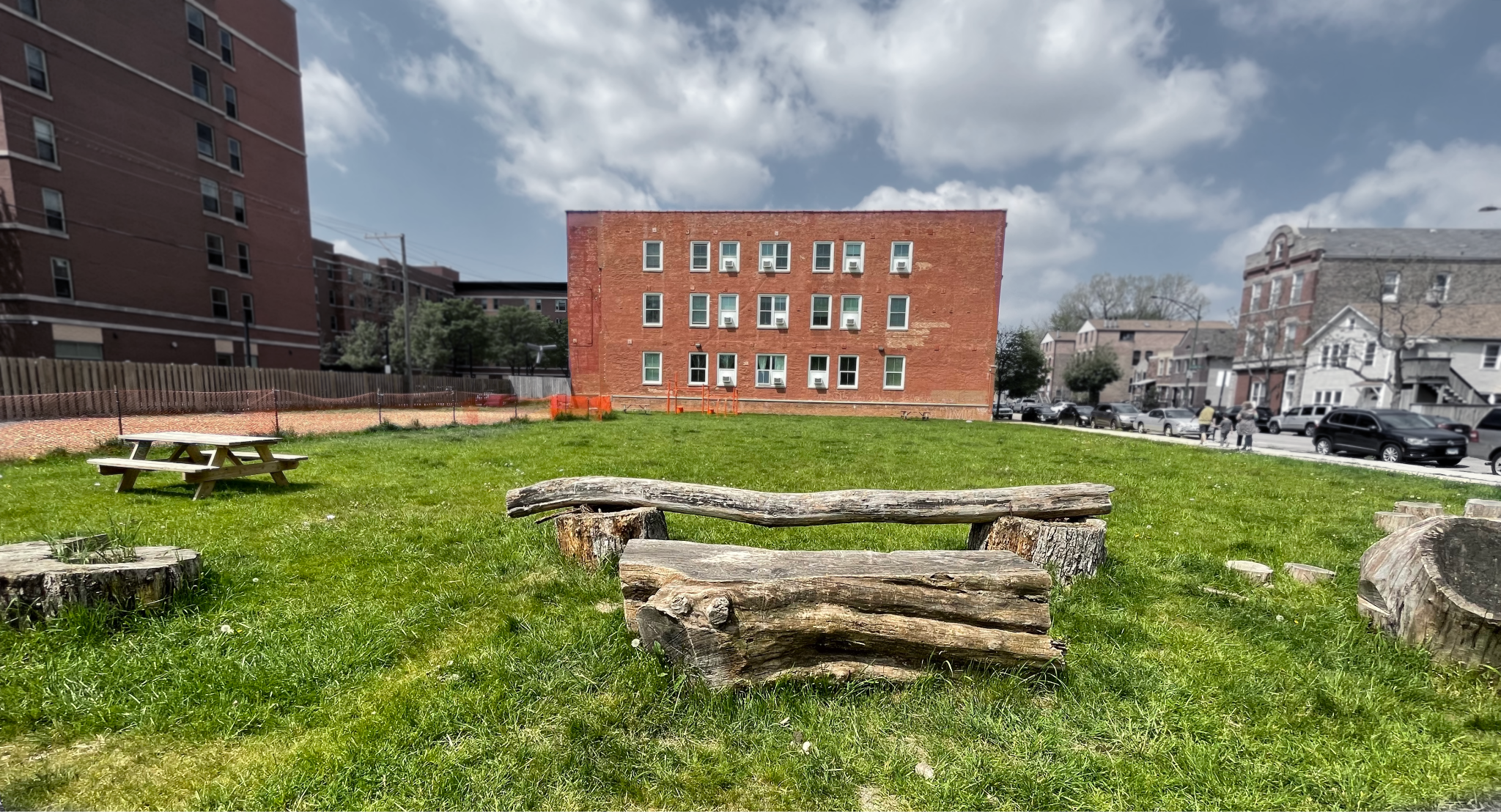
Image by Griffin Seyfried
El Paseo values community member input and aims to incorporate individual ideas into their projects. Community driven installments have been shown to improve a sense of ownership and connection to the space while displaying the values of the community. In 2020, at the outset of the garden expansion along Cullerton street, the leaders of the garden recruited gardeners and local residents to vote on which features to install. In order of interest, features included a dog run, a nature play space, picnic/seating areas, open play areas, a fitness area, and a performance stage.
Since 2021 the incorporation of the new features has been underway: a temporary fence outlines a wood-chipped dog run area that seems to always be occupied. A steel beam exercise area has been placed at the east end of the dog run and has been the site of the annual Pull Up Park Jam calisthenics fitness competition which leverages additional pop up fitness equipment. A series of tree stumps currently constitute the nature play area and is perfectly suitable for a game of ‘the floor is lava’. Expansion is important to the community as the garden is an ever evolving project, and the inclusion of more features allows residents to get involved in a variety of ways.
Beekeeping

Image by Griffin Seyfried
The El Paseo community garden offers a beekeeping membership that includes a hands on practicum. The practicum includes topics of beekeeping theory such as bee biology, Varroa mite management and treatment, swarm prevention methods, and winter preparation. Additionally members get to learn about Hive assembly and bee relocation, manual inspection techniques, how to identify a queen, how to asses colony health, pest and disease identification, colony splitting, bee feeding practices, and honey harvesting.
Members of the program are able to contribute their harvest to the community garden farmers market stand alongside other harvested items while taking home with them a 4oz jar of honey. The program goes from April through November.
The Permaculture Site

Image by Griffin Seyfried
El Paseo Community Garden’s Permaculture Site is a beautiful and functional space for visitors to learn about native plant communities of the Chicagoland area and contribute to the “permanent agriculture” of the garden. Located on the north end of the garden towards Cullerton, the site features a food forest and a plant library that showcases native plants and their uses. The community-managed space is maintained by volunteers who follow the Foragers Rule of Thumb (taking less than ⅓ of any particular harvest) to ensure that the site thrives year after year. The site also offers opportunities to join the “swamp” team and participate in Stewardship Days every Sunday during the garden season (April – October).
The Permaculture Site is based on three ethics: Earth Care, People Care, and Fair Share. Building on these ethics, this site is home to many birds and insects and, as such, visitors are asked to be mindful of the diverse range of species that make this place their home. The site was designed to educate visitors so that they can be equipped with additional information to plant these species in their own backyard and more easily identify and engage with them throughout the city.
This site came into being with help from the 2018 Comed Green Region Grant, the 2019 Openlands Treeplanters Grant, and a Country Financial Sponsorship. Nina Lawrin, owner of Loveren Collections, is the head designer of the site and leveraged the support of Everyday Forage and Permaculture Chicago Teaching Institute to create the plant library.
The Hive
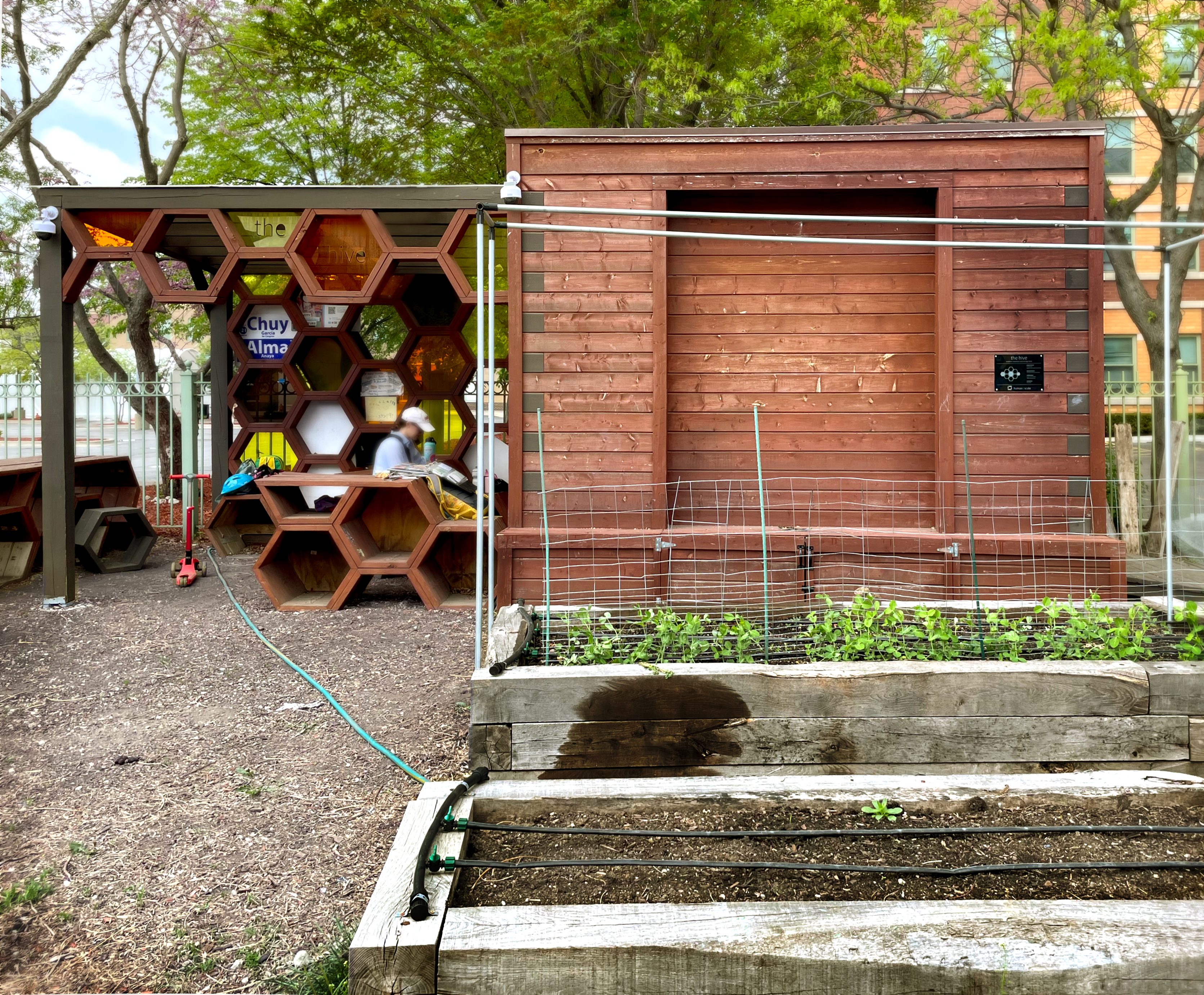
Image by Griffin Seyfried
The garden boasts a beautiful honey-comb inspired outdoor learning space dubbed “The Hive.” A nature-inspired play area and classroom, it was crafted in the image of a langstroth hive and incorporates design elements that fuse together form and function. To bring this ambitious project to life, the organization joined forces with Human Scale, a dynamic nonprofit founded by a group of UIC Architecture students, and received additional funding from The Epstein Foundation.
Beyond hosting the Kids Garden Days program, The Hive also features a charming mini café generously sponsored by Cafe Bustelo, perfect for fueling up while learning about the flora and fauna growing across Chicago. With its focus on nature, creativity, and community, the outdoor classroom and shed is a versatile and adaptable space, providing opportunities for group activities, gardening workshops, and special events. Its playful design encouraged curiosity and discovery, with a range of interactive features to delight and inspire young learners.
Private Planters
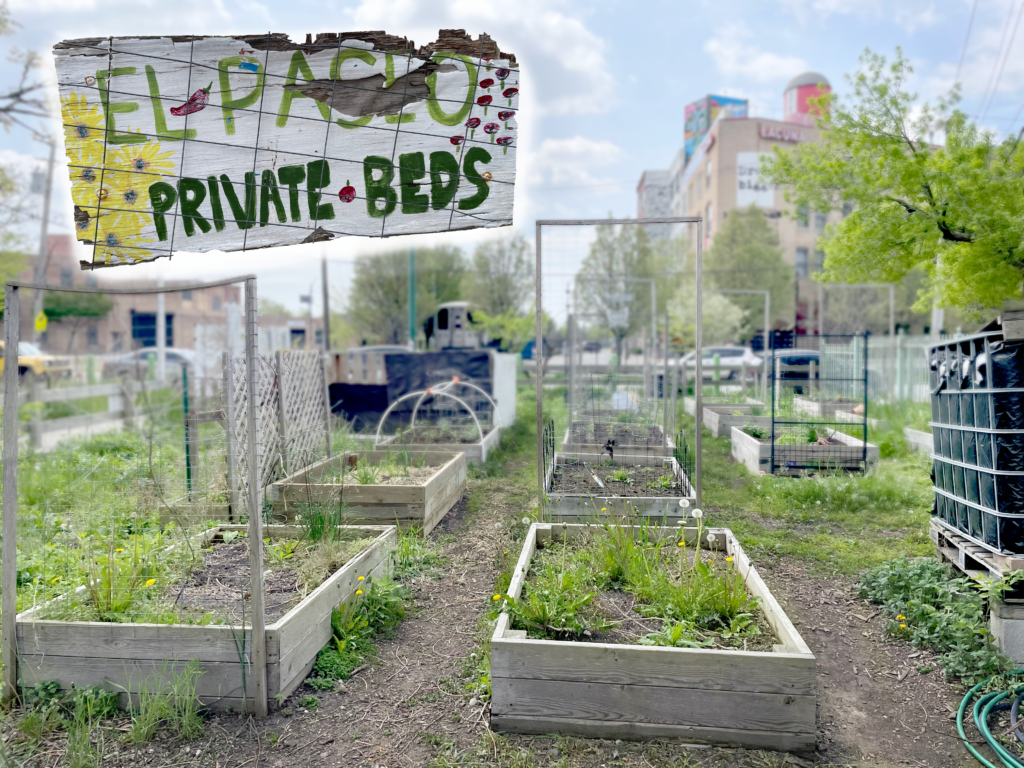
Image by Griffin Seyfried
The El Paseo private garden beds allow members of the garden to grow and cultivate their own flowers and vegetables. Predominantly rented and managed by seniors living in the apartment complex next door, this site is both a flourishing community area and the grounds of a micro-theft war (tomatoes and cilantro accordingly). All jokes aside, the garden beds despite being populated by dandelions in the image above, make up some of the most used spaces at the garden and constitute the grounds around which a significant portion of the El Paseo Community revolves. Those who own these planters have mentioned how these plots grant them routine and responsibility that boosts their individual wellness, sense of belonging, and connection to a local culture/place.
Come by the garden during the summer and early fall months to witness the cared for, plump tomatoes, vibrant cucurbits (squash and zucchini), and fragrant cilantro to name a few of the delicacies. Alongside the vegetables, the gardeners that fill the space can be seen with beaming smiles and youthful grace as they water and pluck their crops.
Collective Garden

Image by Sallie Hinkle
The Collective Garden beds are a community space where members work together to plant, maintain, and harvest crops of their choosing. As a member of a team of 35, individuals will have access to two large raised beds and a small area within the larger “farm”. By working together, members can learn from one another and experience the outdoor delights with other patrons.
During the gardening season, which typically runs from April to mid-October, members will work on Sundays to prepare the beds for changing seasons and rotating crops. Collective work is also organized on Tuesday and Thursday evenings from 6pm-7:30pm. Members will plant and sow seeds in the beginning of the season, and as the summer progresses into fall, we will weed, harvest, and replant.
Additionally, members also have access to the compost program and discounted fees for other garden activities and space including the fire pit and patio.
Sources
- https://southsideweekly.com/mapping-chicagos-racial-segregation/
- https://www2.census.gov/geo/maps/dc10_thematic/2010_Profile/2010_Profile_Map_Illinois.pdf
- https://interactive.wttw.com/my-neighborhood/pilsen/history
- https://interactive.wttw.com/my-neighborhood/pilsen/pilsen-community-split-over-who-will-benefit-paseo-trail
- https://www.pewresearch.org/interactives/what-census-calls-us/
- https://www.pewresearch.org/fact-tank/2020/02/25/the-changing-categories-the-u-s-has-used-to-measure-race/
- https://www2.census.gov/library/publications/decennial/1990/cp-1/cp-1-15.pdf
- Pilsen Quality of Life Plan November 2006 (resurrectionproject.org)
- City of Chicago :: Mayor Emanuel Announces ‘Paseo’, Path To Connect Pilsen, Little Village
- FAQ | El Paseo Trail
- https://chicago.suntimes.com/2016/3/20/18366199/paseo-trail-to-connect-pilsen-little-village-neighborhoods
- https://www.mdpi.com/1660-4601/15/10/2233
- El Paseo Community Garden | Empower through Nature (elpaseogarden.org)
- Developers Who Demolish Homes Near The 606, Pilsen Will Be Hit With Fees Through 2024 After Program Extended (blockclubchicago.org)
- https://news.wttw.com/2021/03/22/push-slow-gentrification-pilsen-and-along-606-trail-demolition-fee-advances
- http://www.pilsenstories.com/


